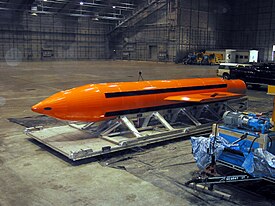GBU-43
| GBU-43/B Massive Ordnance Air Blast | |
|---|---|
 |
|
| Type | Conventional bomb |
| Place of origin | United States |
| Service history | |
| In service | Since 2003 |
| Used by | United States Air Force, Royal Air Force |
| Production history | |
| Designer | Air Force Research Laboratory |
| Designed | 2002 |
| Manufacturer | McAlester Army Ammunition Plant |
| Produced | 2003 |
| Specifications | |
| Weight | 10,300 kg (22,600 lb) |
| Length | 9.1885 m (30 ft 1.75 in) |
| Diameter | 103 cm (40.5 in) |
|
|
|
| Filling | H-6 |
| Filling weight | 8,500 kg (18,700 lb) |
| Blast yield | 11 tons TNT |
The GBU-43/B Massive Ordnance Air Blast (MOAB pronounced /ˈmoʊ.æb/, commonly known as the Mother of All Bombs) is a large-yield conventional bomb, developed for the United States military by Albert L. Weimorts, Jr. of the Air Force Research Laboratory. At the time of development, it was touted as the most powerful non-nuclear weapon ever designed. The bomb was designed to be delivered by a C-130 Hercules, primarily the MC-130E Combat Talon I or MC-130H Combat Talon II variants.
Since then, Russia has tested its "Father of All Bombs", which is claimed to be four times as powerful as the MOAB.
MOAB was first tested with the explosive tritonal on 11 March 2003, on Range 70 located at Eglin Air Force Base in Florida. It was again tested on 21 November 2003.
Aside from two test articles, the only known production is of 15 units at the McAlester Army Ammunition Plant in 2003 in support of the Iraq War. As of early 2007, none of those are known to have been used, although a single MOAB was moved to the Persian Gulf area in April 2003.
The basic operational concept bears some similarity to the BLU-82 Daisy Cutter, which was used to clear heavily wooded areas in the Vietnam War and in Iraq to clear mines and later as a psychological weapon against the Iraqi military. After the psychological impact of the BLU-82 on enemy soldiers was witnessed, and no BLU-82 weapons remained, the MOAB was developed partly to continue the ability to intimidate Iraqi soldiers. Pentagon officials had suggested their intention to use MOAB as an anti-personnel weapon, as part of the "shock and awe" strategy integral to the 2003 invasion of Iraq.
...
Wikipedia
